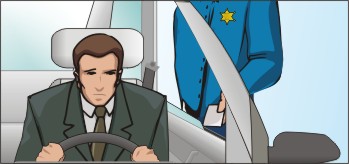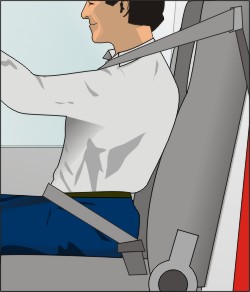We have all heard of the little old lady who lived in a small apartment and died of starvation. When the police went to investigate, they found over $10,000 in cash. She starved to death, yet she had the resources available to survive within her reach. What do you call someone like that?
Now let me pose another question. What do you call someone who dies when survival is within his or her reach? Like someone who dies in a crash because they didn't wear their seat belt. What is even worse is when someone does not put his or her child in a proper safety seat.
Lap/Shoulder Safety Belts

Florida's Law is "Click it, or Ticket!!"
Buckle up, It's the Law!!!
In 28 of the states with belt use laws in 2004, the law specified secondary enforcement. That is, police officers are permitted to write a citation only after a vehicle is stopped for some other traffic infraction.
As of December 2004, 49 states and the District of Columbia had belt use laws in effect. The laws differ from state to state, according to the type and age of the vehicle, occupant seating position, etc.
Research has found that lap/shoulder safety belts, when used, reduce the risk of fatal injury to front-seat passenger car occupants by 45 percent and the risk of moderate-to-critical injury by 50 percent. For light truck occupants, safety belts reduce the risk of fatal injury by 60 percent and moderate-to-critical injury by 65 percent.
In 2004; 31,693 occupants of passenger vehicles (cars, light trucks, vans, and utility vehicles) were killed in motor vehicle traffic crashes. This represents 74 percent of the 42,636 traffic fatalities reported for the year.
Among passenger vehicle occupants over 4 years old, safety belts saved an estimated 15,434 lives in 2004.
Ejection from the vehicle is one of the most injurious events that can happen to a person in a crash. In fatal crashes, 74% of passenger car occupants who were totally ejected from the vehicle were killed. Safety belts are effective in preventing total ejections. Only 1% of the occupants reported that were using restraints were totally ejected, compared with 29% of the unrestrained occupants.1
The facts speak for themselves. Whether you are going twenty miles an hour or eighty miles an hour, you are a lot better off wearing your safety belt. If you want to see first-hand safety equipment in operation, all you have to do is watch the NASCAR races on television. I have seen a car go over the wall and crash on the road below the track and the driver walked away. I know they have a lot more than just a shoulder and lap belt, but I also know that they are traveling over 180 miles per hour. You know what they say on television "Don't try this at home."
The 1999 NHTSA study, Crash Outcome Data Evaluation System (CODES), linked traffic and medical records in seven states to assess total costs of injury from motor vehicle crashes. The study found that the average inpatient costs for crash victims who were not using safety belts were 55 percent higher than for those who were belted. (Most current data available)
Proper Positioning and Adjustments of Safety Belts

Wear lap belts around your hips, not your stomach. Fasten them snugly. Wear a shoulder belt only with a lap belt. F.S. 316.614.
- It is unlawful for any person:
- To operate a motor vehicle in this state unless each passenger under the age of eighteen is restrained by a safety belt or by a child restraint device pursuant to F.S. 316.613, if applicable; or
- To operate a motor vehicle in this state unless the person is restrained by a safety belt.
- It is unlawful for any person eighteen years of age or older to be a passenger in the front seat of a motor vehicle unless such person is restrained by a safety belt when the vehicle is in motion. Under the age of 18, use of seatbelts is a primary enforcement.
Any violation of these laws is considered a nonmoving violation that carries a fine.
No comments:
Post a Comment